|
Promiscuous |
|
From the death of Wolfe to the "birth" of a nation
|
Losers
(Who sometimes win)
In a 1995 chapter of Promiscuous Affections, taking off from the Quebec referendum of that year, I alluded to a few people and events significant in Canadian history yet too rarely recalled -- even by Canadians.
Our story has rarely bred heroic myth. We're a country born of garrison settlements in a vast and hostile land, more conscious of struggles for survival (Margaret Atwood's 1972 study of themes in Canadian literature was called just that: Survival) than of any grand destiny, manifest or otherwise.
Canada was created not in sudden violent unpheaval justified by noble ideals, but gradually, pragmatically, in an evolution born of necessity -- and wariness of a powerful neighbour. As Pierre Trudeau once put it, Canada is a mouse in bed with an elephant.
We tend to recalls trials, setbacks and defeat more easily than triumphant (or triumphalist) victories. We hold our losses dear.
The Canadian Pacific Railway, thrown across the continent in the 1880s, tying together -- unifying, perhaps even preserving -- an independent country in northern North America, may be revered as "The National Dream." But that phrase doesn't tap the depth of sentiment we feel when we hear "The Avro Arrow." It was one of the most technically advanced and beautiful aircraft ever built -- by Canadians, in the 1950s -- only to be broken up for scrap.
We're a nation of migrants, refugees, "displaced persons," some even in our own land. We're losers. But resolute ones. We have learned -- sometimes; often over a very long time -- to turn our losses into victories. (Modestly celebrated, of course.)
The piece below, slightly adapted, first appeared as a sidebar to the 1995 chapter: a tangent very tangential to that chapter's substance; a whim of mine really, and one too overwhelming there.
In August 2000 I pulled it out but didn't scrap it, preserving it here as a separate file, adding some new information, new photos -- and one more story.
So, herewith, an extended tour -- for those who might want to take one -- of a few historical highlights and their later if too rare resonance.
|
The Plains of
|
On the night of September 12, 1759, more than 4,000 British troops launched from warships on the river, under the command of General James Wolfe, scaled steep cliffs to gain the plains and attack the French fortress of Quebec. They were met the next morning by nearly as many French regulars and Canadien militiamen, under Louis Joseph, Marquis de Montcalm. In a battle lasting just 15 minutes Wolfe won the day, but lost his life. So did Montcalm.
The war went on (Montreal captured the next year), ending in 1763 with the Treaty of Paris. Britain got its pick of the spoils -- and nearly picked the sugar rich French West Indian isle of Guadeloupe over the vast northern reaches of New France. And vast they were, running northwest to the Lake of the Woods and all the way south and west to the Ohio and Mississippi Rivers.
In 1774, by an act of the British parliament, all of it became Quebec. This potential expansion of French language, civil law, and Roman Catholicism (all guaranteed by the Crown to its newly conquered subjects) deep into the heart of North America was the least tolerable of what the 13 Atlantic coast colonies called "The Intolerable Acts," helping spark their War of Independence (an invasion of Canada included).
After they'd won, Benjamin Franklin, bargaining terms with the Brits in 1783, wanted them to turn over the entire territory to the new USA. They got the chunk south of the Great Lakes, later called America's "Old Northwest." Old Quebec became the provinces of Upper and Lower Canada.
For French Canadians the Plains of Abraham have forever meant "The Conquest": the end of French power supreme in that land since Jacques Cartier first claimed it for Francis I in 1536; and the dawn of life as a subject people under British governors and the Anglo merchant class. (Pierre Vallières, late '60s radical and later out gay man, would call his people "the white niggers of America.")
Les Canadiens (a term once meaning just French Canadians) retreated to religion, rural poverty, and "the revenge of the cradle" -- their birthrate long (if no longer) the highest in North America. The storm of "liberté, egalité, fraternité" that swept France in 1789 caused not a stir: France had abandoned them; its older values, "la langue, la foi, la race," seemed safer refuge. Quebec remained hide bound and priest ridden for the next 200 years.
It would throw off the veil only in the 1960s, the "Quiet Revolution" creating a more open, secular society. With the 1976 election of a separatist government (and more since), Quebec has vigorously defended its distinct culture. Once the only bilingual province (to protect English), it now has only one official language: French.
With that it's a more confident culture -- if with a long memory. The slogan on Quebec licence plates, long "La belle province" (the usual tourist bumf), has since been "Je me souviens" -- "I remember." And what they remember is The Conquest.
|
Rebels, 1837-38
|
It was a conflict widespread (with battles across the south St Lawrence and Richelieu Valleys), protracted (early November 1837 to the spring of 1838), and bloody: 325 dead, mostly Patriotes. Papineau fled but returned, later elected to the legislature. He died peacefully in 1871.
William Lyon Mackenzie led the Rebellion of 1837 in Upper Canada (now Ontario). He'd long been a critic of the ruling elite -- dubbed the "Family Compact" -- as publisher of The Colonial Advocate (its type trays once tossed in the harbour by some of the Family's younger members), and as first mayor of the City of Toronto on its incorporation in 1834.
Upper Canada's rising was small beer (a tavern battle included) compared to the Patriotes', theirs opening the way for Mackenzie: most local troops had been sent off to Lower Canada. On December 5 some 600 farmers marched down Yonge Street to take the capital, meeting resistance on turf now beneath Maple Leaf Gardens -- or nearly, the exact site unclear.
After just a few shots both sides fled -- as one wag later put it: "the first mutual retreat in the history of warfare." (Sensibly Canadian, no doubt).
The rebels retreated north to Montgomery's Tavern, where they were scattered. There had been three fatalities. Mackenzie fled to the US, also returned (at first with a small army; in time peacefully), later elected to the legislature. Friends bought him a house at 82 Bond Street, where he died in 1861.
Many Patriotes and rebels were jailed, many more exiled to penal colonies in Australia, 29 executed. Best known (at least outside Quebec) are Samuel Lount and Peter Matthews, tried for "treason and insurrection," convicted, and publicly hanged outside the Toronto courthouse in 1838.
The more subtle handling of their leaders grew from the fact that, over time, their failed rebellions did not fail entirely.
Those risings led (via a report by the Earl of Durham, sent to investigate) to responsible government -- British overseers directly accountable to local legislatures, not the Colonial Office at Westminster. This was less than many rebels had fought for, but enough for their more temperate Reform allies -- who in time were running the show.
Less nobly, Durham pushed the unification of Upper and Lower Canada into the single Province of Canada -- in hopes of swamping the French in an Anglo majority tide. It didn't work: Toronto Reformer Robert Baldwin and Patriote Louis Hippolyte Lafontaine worked to secure responsible government and led a united (if sometimes fractious) Canada into the early 1850s.
Matthews and Lount, buried in the paupers' Potter's Field (near the modern Bloor and Yonge), were later reinterred at The Necropolis, a monument raised to them there by "sympathizers and friends" in 1893. Mackenzie lies in The Necropolis too. His house is now his museum; his defiant bust sits atop a plinth at Queen's Park, behind him a sad soul pushing a plough -- one of our most gracefully composed, if ignored, public sculptures.
Canadian volunteers enlisting to fight Franco in the Spanish Civil War dubbed themselves the "Mac Paps" -- the Mackenzie Papineau Battallion. In the '60s the Front de Libération du Québec claimed the 1837 Patriote flag (bands of green, white, and red) as their banner, naming their secret cells for heroes of the rebellion.
But beyond that, 1837-38 rarely echoes today, even as the origin of responsible government -- Canada's distinct contribution to erstwhile colonies now parliamentary states worldwide. ("It's a Canadian idea," young Queen Victoria says in a TV "heritage minute"; her maid says, "Pity, mum" -- parody of promo for Red Rose tea.)
Despite their pioneering role in Canada's constitutional history (and in historic cooperation between French and English Canadians) Baldwin and Lafontaine are rarely recalled -- but for another of those TV heritage minutes. Baldwin now lies obscure in Toronto's St James Cemetery, nothing there marking his mark on the country.
(More grandly honoured -- if by proxy -- is his grandson Robbie Ross, who at 17 was the first man to seduce Oscar Wilde. Ross stuck with Wilde through his trials and beyond, remaining loyal even in death: his ashes are interred in Wilde's tomb at Père Lachaise in Paris.)
Baldwin and Lafontaine were overtaken in history by another Anglo (or rather Scot) / French duo, John A MacDonald and Georges-Etienne Cartier, around for Confederation. Sir John became, officially, "our first prime minister" on July 1, 1867.
That date is now tamely celebrated as "Canada's birthday" -- as if it had been born out of nothing at all.
Its deeper origins are suggested in the back garden of Mackenzie's Bond Street house, on a wall erected there in 1938, bearing carved medallions of Matthews and Lount, and these words:
- This memorial was erected to honour the memory of the men and women in this land throughout their generations who braved the wilderness, maintained the settlements, performed the common tasks without praise or glory and were the pioneers of political freedom and a system of responsible government which became the cornerstone of the British Commonwealth of Nations.
|
Louis Riel
|
They hoped to hold out for terms protecting their religion, language and culture in the annexation of the territory as a province of Canada. Their chosen leader: messianic visionary Louis Riel.
Rowdy Ontarians hungry for land poured in, some so rowdy Riel had them jailed. Thomas Scott, a rabid anti Catholic Orangeman, escaped, was captured, tried, and so abused his accusers he was sentenced to death, shot March 4, 1870 by a Métis firing squad. Orange Ontario rose; Ottawa sent in the army to "restore order."
Red River became the Province of Manitoba in July 1870, sending Riel to parliament in Ottawa -- twice, only to be twice expelled. He fled to the US, drifted in and out mental asylums, becoming a teacher at a Catholic mission in the Montana Territory.
|
Louis Riel
|
The Northwest Rebellion of 1885 (as history came to call it), was a chance for the fledgling Dominion of Canada to flex its muscles. The army, rushed out on the newly completed Canadian Pacific Railway, attacked Batoche and after a four day battle took it on May 12.
Riel surrendered and was deemed sane enough to stand trial. Convicted of treason, he was hanged at Regina, November 16, 1885 -- making him that most Canadian species of hero: a martyr.
Gabriel Dumont became a poster boy for 1960s radicals. Riel returned in the '70s, as a statue on the back lawn of the Manitoba legislature. Even in bronze he caused a stir: for some because the sculpture (replete with his agony) seemed grotesque; for others simply because it was Riel.
The Goverment of Canada later officially exhonerated him, his redemption controversial even after a century in the grave.
|
Vimy Ridge
|
In 1915 the French had seen 130,000 men killed or wounded trying, and failing, to wrest this strategic site from the Germans. On Easter Sunday, April 9, 1917 it was assaulted by Canadians in their first action as Canadians together, rather than scattered among British troops. By April 14 they had taken the ridge -- and more than 10,000 casualties, among them 3,600 dead.
In July 1936 a huge memorial at Vimy was opened by King Edward VIII. (He of Mrs Simpson and no coronation. Toronto has an odd monument to him: Postal Station K, the only one built during his brief uncrowned reign, bearing his royal crest: E VIII R. It sits on the site of 1837's Montgomery's Tavern.)
The monument's two towering pylons, one for Canadians killed there, the other for French, rise atop the ridge, put there as it says on their base "by the people of Canada ... in memory of their 60,000 dead" in World War One.
That war, the Battle of Vimy Ridge in particular, would come to be seen as "Canada's coming of age as a nation."
In 1914 Canada, as part of the British Empire, had automatically been at war with Germany as soon as Britain was. By 1939 it was effectively independent, made so by the Statute of Westminster in 1931. Prime Minister William Lyon Mackenzie King (grandson of the rebel of 1837) pushed the point, not asking Parliament to declare war until September 10, 1939 -- a week after Britain had. This was perhaps the nation's true coming of age.
From both 1914 and 1939, Canada was at war for some years while the US remained neutral. I have an odd relic of one such year, 1940: a book called Canada: America's Problem. "For 150 years the U.S.A. has taken Canada for granted," says its blurb. "Suddenly Americans are asking vital questions about their neighbor's status. Rival? menace to peace? or partner?"
We've hardly been paid such attention since....
|
Norman Bethune
|
Always a man of radical bent, he joined the Communist Party in 1935. A year later he was enmeshed in the Spanish Civil War, setting up and running Servicio Canadiense de Transfusion de Sangre, the world's first mobile blood supply service. (Hollywood producer Otto Preminger once briefly pondered a film based on it, rumoured to be titled Blood on Wheels.)
In January 1938 Bethune was off to China, writing his wife then: "I refuse to live in a world that spawns murder and corruption without raising my hand against them." He became surgeon to Mao's army, not yet having fought its way out of the mountains, training thousands as doctors and medics, and creating the first mobile medical units.
He died in his work, of septicemia, on November 12 1939, later interred in China's Mausoleum of Martyrs near Beijing. A hospital named for him stands nearby.
Mao wrote on Bethune, calling him "a model of internationalism, responsibility, and devotion to others." (Perhap it's best Bethune died too early to know how Mao turned out.)
His birthplace in Gravenhurst, Ontario is now a modest museum -- if to the Chinese a shrine.
|
Dieppe
|
The lessons of Dieppe, learned at great cost, would be put to good use (and much better honoured) in the invasion of Normandy on D-Day, June 6, 1944.
There's a TV bit on this, too: a commercial. A vet gets a call from his grandson touring France, he suspects frivolously. "Where are you?" The boy answers (a catch in his voice; a sudden take on grandpa's face): "Dieppe" -- on the beach, at a monument to its Canadian dead.
A sappy use of history, pushing cell phones, but Canadian history recalled in a way too rare.
|
The Avro Arrow
|
The company had a worthy track record: its Avro Jetliner had been the first passenger jet to fly in North America -- and just the second in the world, the Brits beating it by two weeks -- in 1949. Ahead of its time, as it turned out. Avro's new plane would be as well.
The first CF-105 Avro Arrow rolled onto the tarmac at Malton on October 4, 1957. Its sleek delta wing design was unprecedented (not seen again until the Concorde more than a decade later); in its first test flight it reached 1,300 miles per hour, nearly twice the speed of sound. The US, Britain -- and Russia -- were stunned.
But the Russians (and Americans) would win out. On that same October day the Arrow was rolled out, Sputnik was launched into space: intercontinental ballistic missiles, not the bombers potentially targetted by the CF-105, would become the main threat. The US gave the Arrow short shrift, favouring its own defense contractors -- who still built bomber intercepters, if for many years none matching the speed of the Arrow.
Facing cost overruns and a collapsing market, the government of prime minister John Diefenbaker scrapped the Arrow on February 20, 1959. Its 14,000 makers came to call it "Black Friday": all lost their jobs on the spot. (Some went on to NASA, others later worked on the Concorde.)
The six finished planes -- along with all their related documents, tools and equipment -- were ordered destroyed. What was left of the Arrows was sold as scrap, at six and a half cents a pound.
All that remains (but resentment and failed dreams) are a few parts, among them the needle nose and front landing gear of the Arrow's final version, designed with new Canadian Iroquois engines to fly at 1,500 miles an hour. It never did. It now stands anchored to a wall by its aft end -- still blackened where it was blowtorched from its fuselage -- at the National Aviation Museum in Ottawa.
Despite the setback, Canada remains a force in the aeronautics and aerospace industry: Bombardier's 60 to 90 seat Canadair regional jets and smaller executive class Challengers fly all over the world; the Canadarm goes up with each launch of the Shuttle (though its creator, Spar Aerospace, has since been bought by a US firm).
Still, no one has ever made of those any mythic docudrama. The CBC did do one in 1997, if giving it a title of less than towering portend.
The story didn't need any help. It was enough to call it The Arrow.
To those who have completed this tour, my thanks. But you should also thank me -- for not getting into the War of 1812. The enemy then was the Americans -- and they lost. Or so Canadian history has it and we should know: there is still a Canada, which was not at all the US intent of the day.
[A later piece on this site pays much attention to one episode of that war: the April 1813 Battle of York (now Toronto). See York's fort, Toronto's reserve, in One Street, Many Stories: Queen]
Some sources
W L Morton: The Kingdom of Canada: A General History from Earliest Times. McClelland & Stewart, Toronto, 1963. Joseph Schull: Rebellion: The Rising in French Canada, 1837. Macmillan of Canada, Toronto, 1971. William Kilbourn: The Firebrand: William Lyon Mackenzie and the Rebellion in Upper Canada. Clarke Irwin & Company, Toronto & Vancouver, 1956.
On the Internet:
Canada: A People's History (http://www.cbc.ca/history). Website for the epic series, a joint production of CBC Television and Radio Canada in both English and French: 17 episodes, two hours each, ranging from the first aboriginal settlements tens of thousands of years ago to the year 2000. Launched in late 2000, airing for two years, it is beautifully shot, historically scrupulous (I have it to thank for correction of a few errors I found I'd made here) -- and gripping. Every word spoken by every character -- from prime ministers and generals to farm wives and footsoldiers -- is his or her own, gleaned from journals, diaries and letters. It is, very much, the stories of losers who sometimes win.
All images on this page, unless otherwise credited, courtesy of the Toronto Reference Library.
Spadina Avenue, in 1971
Or go back to Contents or
My Home Page
This page: http://www.rbebout.com/bar/oft.htm
Go back to whatever point of historical resonance sent you here:
The Necropolis, in 1990: Apr-Dec
The Quebec Referendum, in 1995: Oct-Dec
January 2000 / Last revised: June 8, 2007
Rick Bébout © 2001-2007 /
rick@rbebout.com
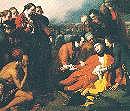
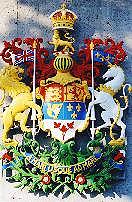
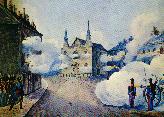
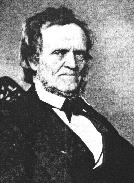
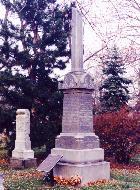
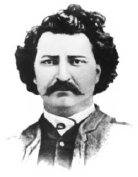
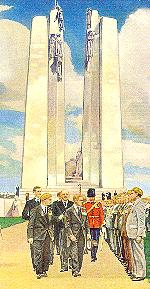
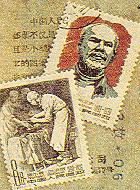

 Ahead of its time:
Ahead of its time: